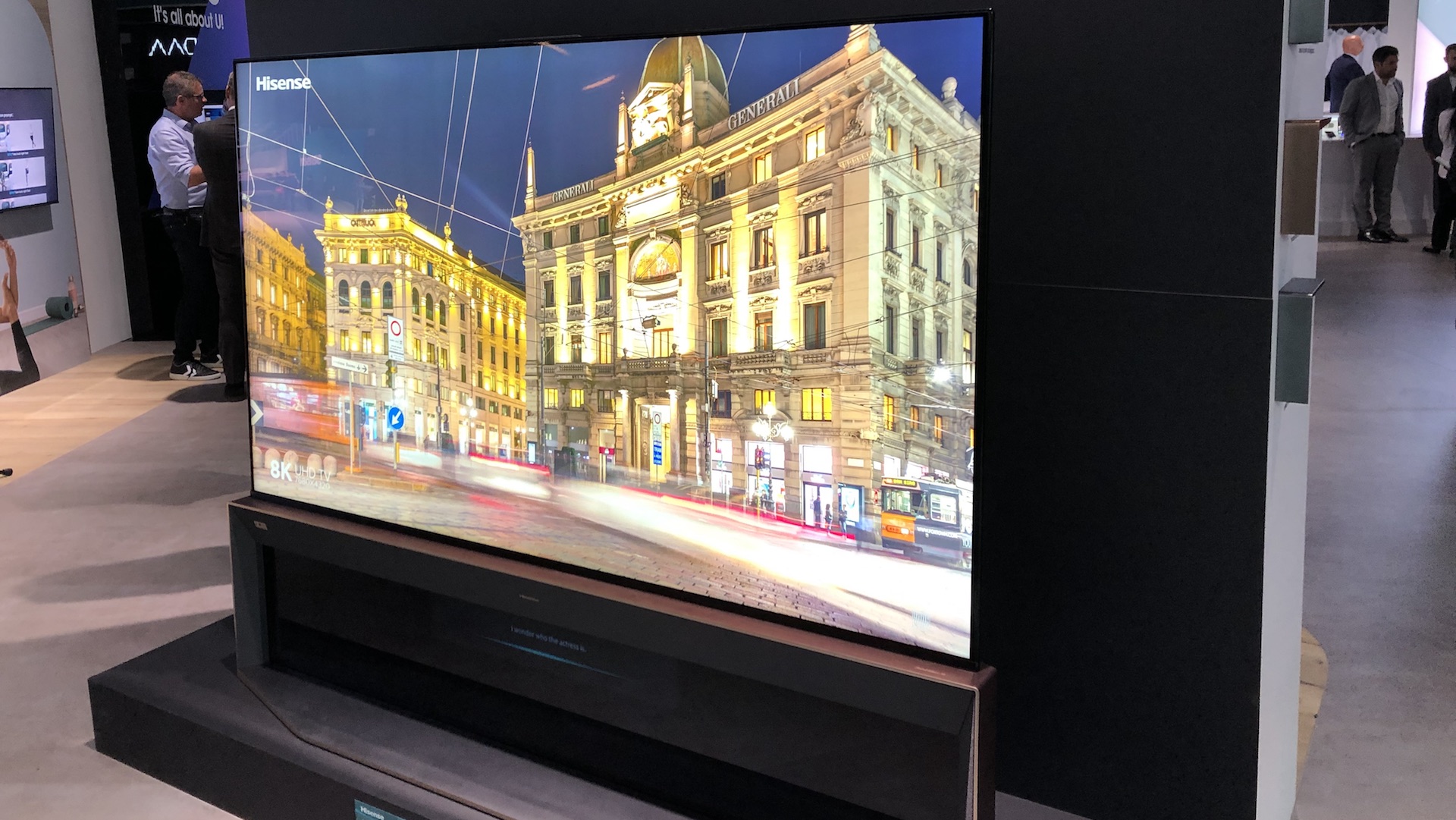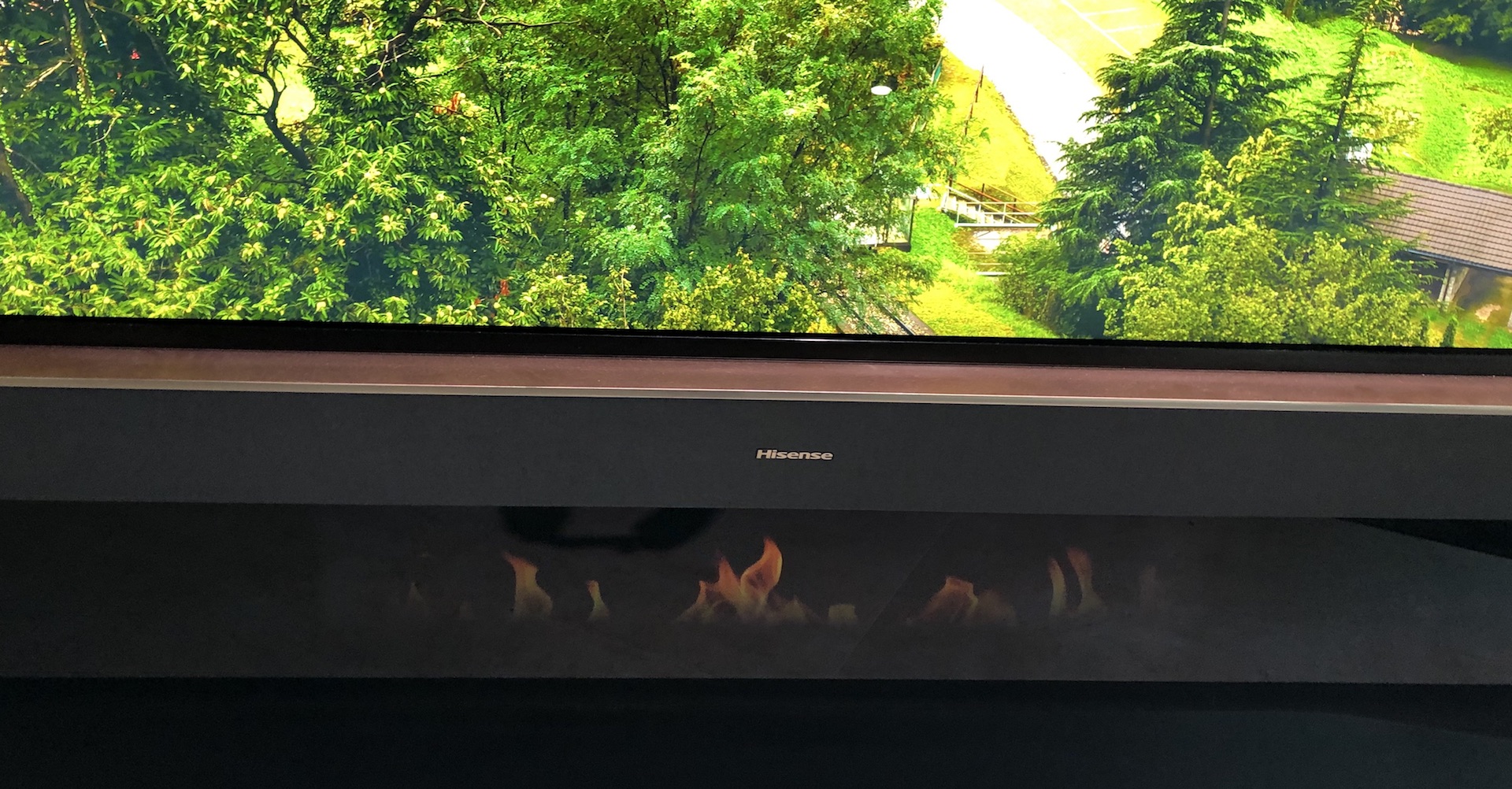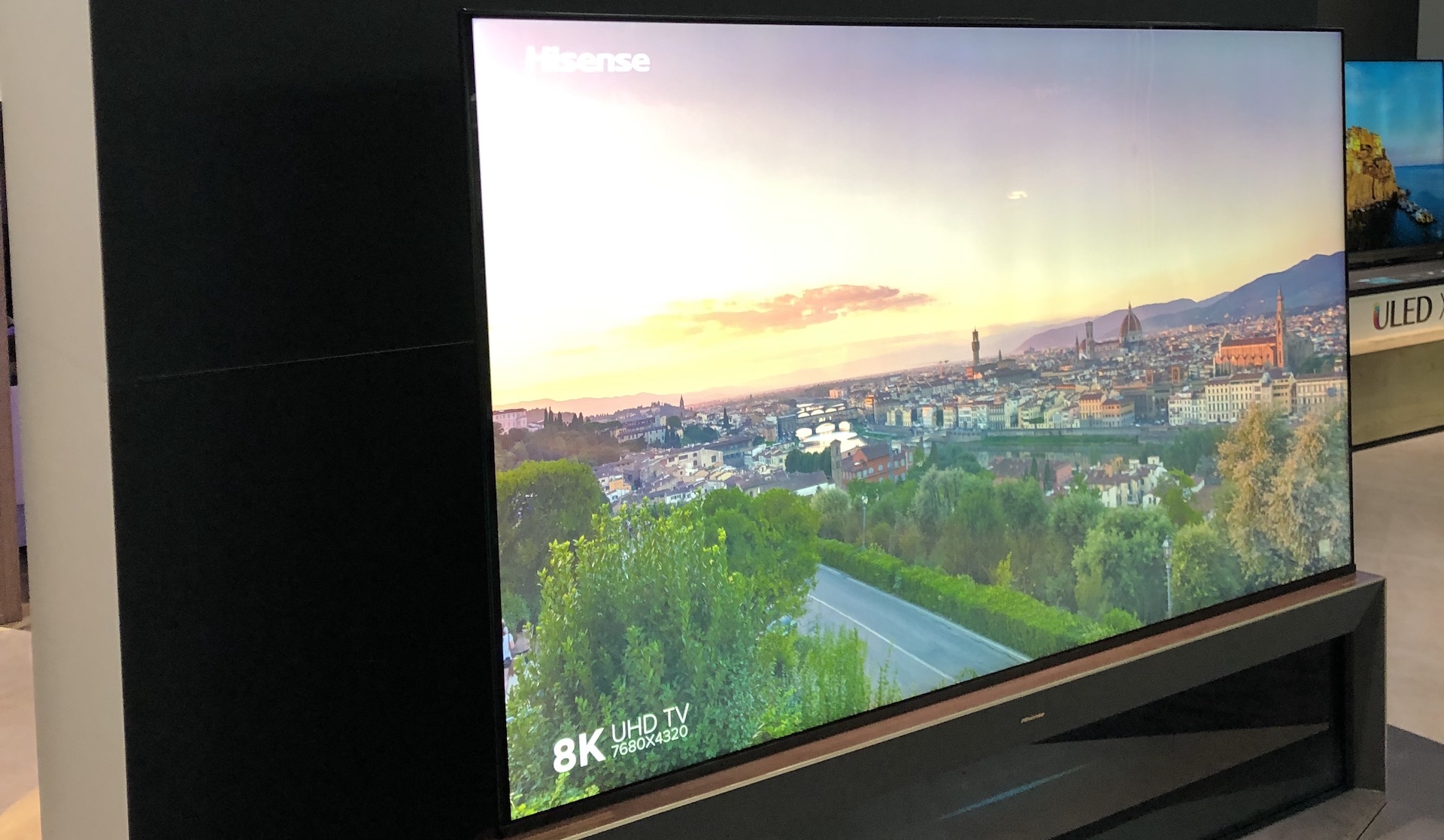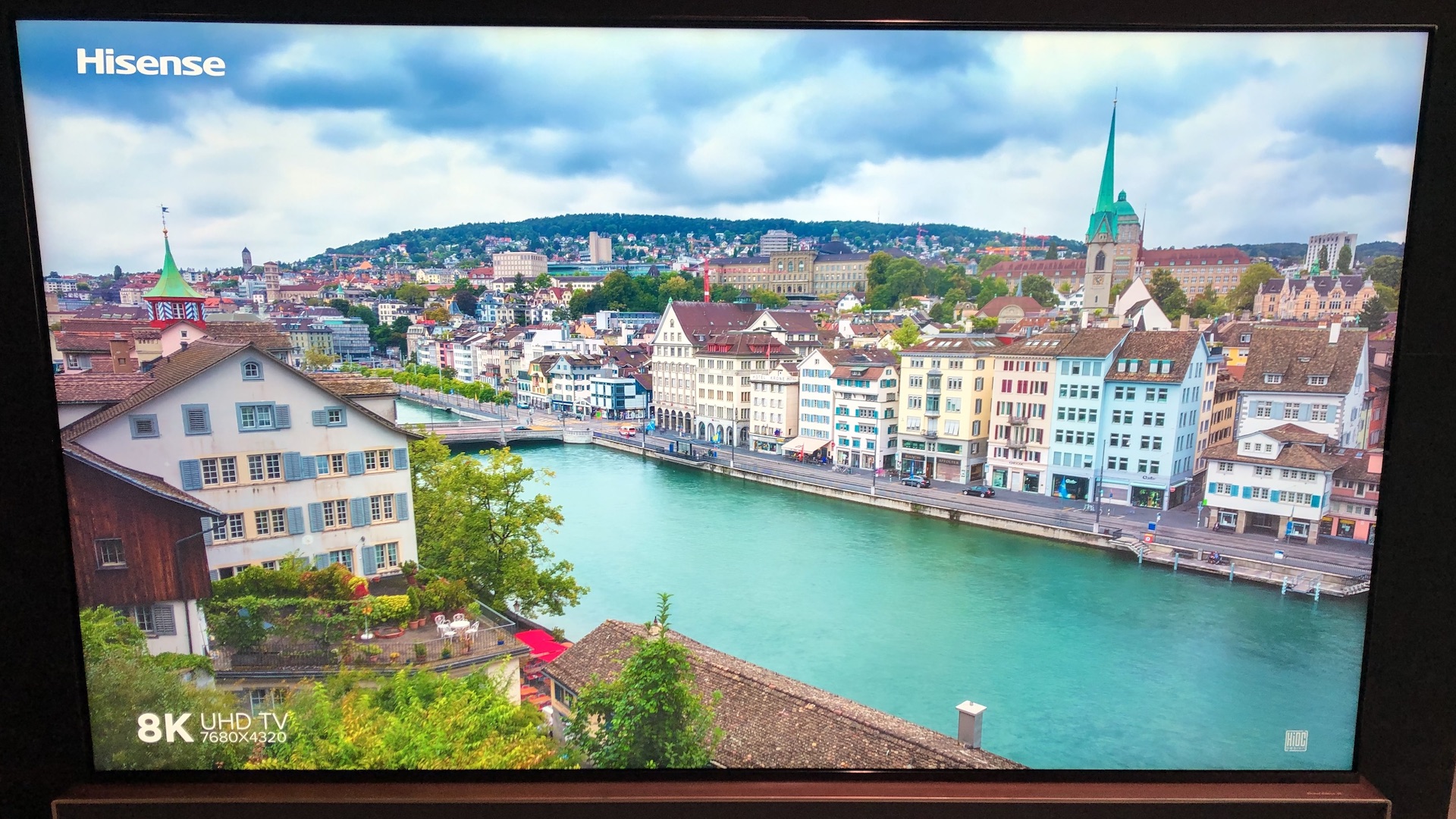Early Verdict
Hisense's other 8K TV at IFA 2019 will need some work if it's to impress in western markets.
Pros
- +
Interesting second-screen idea
- +
4.2.2 multichannel speaker system
Cons
- -
Humble contrast
- -
Lifeless colors
Why you can trust TechRadar
Hisense was showcasing not one but two 8K TVs on its stand at the IFA 2019 technology show in Berlin.
One early prototype using dual cell technology, the Hisense Dual Cell ULED HZ65U9E, we’ve already covered in a separate article.
Here we’re looking at a more straightforward (in some ways, anyway) 8K LCD model that’s already available in the Chinese market, and as such maybe gives us a better idea of what a more mainstream Hisense 8K TV might look like.
Price and availability
Hisense has yet to share details of availability for the HZ85U9E in western markets.
However, it's a giant 8K TV screen, so expect it to command a high price tag, and that's even by the usually-more-budget-friendly standards of the Hisense range as a whole.
Design
The first thing you notice about the HZ85U9E is its size. In keeping with the pretty logical idea that 8K makes more sense on big screens, it’s 85 inches wide. That’s 10 inches more than Hisense’s dual cell 8K prototype, and the extra size does help sell the impact 8K can have. At the same time, though, the HZ85U9E also provides a poignant reminder that when it comes to all-round picture quality, resolution isn’t everything.

Before going into more detail on my first impressions of the HZ85U9E’s picture performance, there are a couple of unexpected ‘bonus features’ to report. First, the screen slots into the top of a large floor-standing bit of furniture that boasts not only a gleaming champagne finish on its top edge, but also a built in 4.2.2 multichannel speaker system.
Second, in a move I’ve never seen before, Hisense has built a narrow second screen into the stand below the speaker. This can be used to show a range of relaxing screensavers (of which a flickering fire was the most effective). Or you can use it to show weather and news reports. Or, most usefully, it can be used as an extension of the TV’s interface, from which you can browse app content and choose stuff to play on the main screen.

Before anyone gets too excited by this startling innovation, though, it seems that the HZ85U9E on show at IFA is a Chinese special edition, and that any version sold in Europe would likely not ship with this extra screen. Also, it seemed that on the IFA floor that the second screen wasn’t bright enough to be as helpful as it might have been.
Performance
Getting back to more ‘nuts and bolts’ stuff, the HZ85U9E impressively backs up its 8K pixel count with a massive 1694 zones of local dimming. This is far short, of course, of the million dimming zones you get with Hisense’s dual cell technology. But it’s huge by the standards of ‘regular’ LCD technology. Samsung’s flagship Q950R 8K TVs, by comparison, only carry 480 dimming zones.
Also promising is the HZ85U9E’s use of Quantum Dots for its colors, meaning its palette should hopefully extend far enough to deliver more of the color volumes associated with today’s premium high dynamic range and wide colour content.
In recognition of the current dearth of native 8K content, meanwhile, Hisense has again followed Samsung’s lead in turning to a new AI-based approach to upscaling for the HZ85U9E. Since Hisense was only showing a native 8K demo reel, though, I wasn’t able to check this key aspect of the HZ85U9E’s performance out for this first look.
From what I was able to see of its 8K performance, though, even a brilliant upscaling effort wouldn’t have been enough to erase a number of significant picture quality concerns.
Right away the picture feels rather flat and milky - even when showing bright, colorful footage, such as shots of a quaint mediterranean sun-drenched village. This is a sure sign of potential contrast issues - something that’s confirmed when Hisense’s demo reel switches to darker scenes. These look washed out, grey and generally unconvincing. Especially in comparison with the dual cell 8K Hisense prototype sitting a few metres away on Hisense’s IFA stand, but also by the standards of really any current premium 4K or 8K LCD TV.

The HZ85U9E’s limited contrast abilities also reduce the impact of its 8K resolution to some extent. You can, for sure, still appreciate that the image is native 8K. Fine detail levels in the demo footage’s buildings and landscapes are clearly higher than they would be on a 4K screen. However, the HZ85U9E’s relatively humble contrast means that the sense of definition and, especially, depth in its 8K pictures isn’t nearly as pronounced as it is on other 8K screens we’ve seen, such as Samsung’s Q950Rs, LG’s OLED88Z9 set, or Hisense’s own 8K dual cell prototype.
The HZ85U9E on show at IFA also suffered quite obviously, too, with dirty screen effect, where the image looks during camera pans as if it’s got smudges over it. In fact, this even turned into quite defined vertical bands of shadowing at times - especially, again, during dark scenes such as, ironically, Hisense’s branding screen of a blue logo on a black backdrop.
Add in some rather lifeless colors, which join the HZ85U9E’s contrast in not seeming to have what it takes to ‘keep up’ with the screen’s high brightness, and you’ve got a picture performance that doesn’t feel like a truly appropriate ‘heart’ for a TV that’s sold in China as premium set.
Early verdict
Perhaps aware of this screens limitations, Hisense’s representatives at IFA seemed doubtful about whether the HZ85U9E would ship to other territories in the same sort of premium configuration. In fact, it seems possible that Hisense may wait until its 8K dual cell TV is ready to ship before making its global 8K move.
While the HZ85U9E might not have the secondary attributes to do anything like full justice to 8K’s potential, though, there’s still maybe an argument for stripping its screen part out, updating its software, and maybe positioning it as the world’s first truly affordable 8K set? Watch this space, it seems.
John has been writing about home entertainment technology for more than two decades - an especially impressive feat considering he still claims to only be 35 years old (yeah, right). In that time he’s reviewed hundreds if not thousands of TVs, projectors and speakers, and spent frankly far too long sitting by himself in a dark room.
What is a hands on review?
Hands on reviews' are a journalist's first impressions of a piece of kit based on spending some time with it. It may be just a few moments, or a few hours. The important thing is we have been able to play with it ourselves and can give you some sense of what it's like to use, even if it's only an embryonic view. For more information, see TechRadar's Reviews Guarantee.

